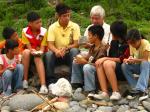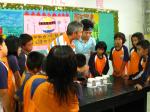Monthly Archives: November 2009
Episode 59: Making of the Canoe
Lanyu (Orchid Island) is home to the seafaring Tao people, famous for their elaborately designed canoes. But they’re not just for show. The structure of these canoes are based on scientific principles that maximize efficiency for the Tao fishermen. The making of the canoe requires 27 pieces of wooden boards, connected through step cuts and stabilized by wooden nails. Not every piece of the board has the same function, so different timber are used for the boards. The spine of the structure must be solid, so they use longan wood. The sides use timber from mango trees or persimmon tree. These two kinds of wood have lower density and floats better. They also expand when in contact with water, making the canoe more secure.
The kids use paper clay to make their own canoes to understand how friction increases hull strength.
Episode 58: Pottery
Pottery making is a part of the lives of early Amis women. When making pottery, they must first collect earth. After removing the impurities, they must be wedged. The Amis use pieces of bamboo to beat the clay into shape. Once it is dried, then the first step is finished. Amis villages commonly use the wild firing method. Materials used for burning are natural, such as grass, rice husk, etc. During firing, the control of temperature and humidity is very important. Also, due to the carbon within the charcoal, some pottery may have black spots. Only after more than 10 days of drying and firing is the work finished.
Episode 57: Flint
The flint is a necessity for the early Amis when they go into the wild. The expert of this episode picks stones off the ground and produces sparks. To understand the scientific principles of a flint, the science teacher helps kids understand the characteristics of a quartz. By understanding the structure of a quartz crystal as well as how electrons are released, the kids know that when a quartz is beaten against iron, high temperature is released instantaneously, releasing electrons and sparks.
Episode 56: Slingshot
A good slingshot must be in the shape of a Y, and made from a sturdy wood. The most important is that the two leather cords must be of equal length. If not, the slingshot would not be accurate.
Derived from the slingshot, the scientific principle of this episode discusses that the rotation generated when an object travels may cause irregular shaped stones to experience uneven air resistance, causing the object to stray and not hit the target. The shape of the object effects its movement, and can greatly affect the shot accuracy.
Episode 55: Mountain Spring Pipe
In this episode, the science teacher shows kids the principle behind siphoning. Liquid moves from an upper reservoir to a lower reservoir because the pressure of the liquid in the end of the tube is greater than the surrounding pressure in the lower reservoir. When the water level of the two reservoirs are the same, and their atmospheric pressures are equal, the siphoning stops. Also, if air is in the tube, then the water would not flow. That’s why the villages always need ventilation pipe to discharge the air for the water to flow smoothly.













